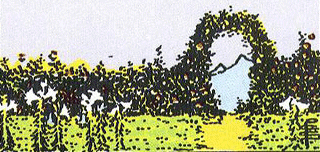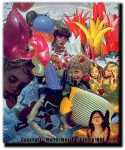
Postmodern Decks: Beginning With T-V
This page is part of a larger tarot site. Click here to start at the top.

Tarot of the III Millenium. Iassen Ghiuselev. 2000 Lo Scarabeo, Italy. - "I don't know if humanity is able to fully understand the transformations of this age, if it is able to live with the conflict between spirit and technology, between oneself and the madness which surrounds it. Please convince me that I'm wrong. The threshold of the III Millenium has been crossed."

- A Picture Is Worth 1000 Words - Cold War and Beyond
- Page at Trigono with Card Samples
- A Tarot Garden Interview with Lo Scarabeo's Riccardo Minetti
- David Roell's Review
- Aeclectic Tarot - 3 1/2 stars
- Joan Bunning
Tarot of the Trance. Eva Maria Nitsche. 1998 US Games Systems. - The art on this deck, by a German artist, is reminiscent of Wixarica/Huichol Art or one of the contemporary psychedelic paintings exhibited at Erowid. The art is primitive in style, eye-poppingly bright, and the space is filled with intricate geometric designs.


- An Introduction to Trance Art By Barry Kavanagh The trance artists discussed are Austin Osman Spare, Rosaleen Norton, and Victor Angel.
- David Roell's Review
- Joan Bunning
- Rev. Gina M. Pace's Review at Wicce's Tarot Collection
- Aeclectic Tarot - 3 1/2 stars
- Tarot Deevah's Review
- Angel Paths Review
Ukiyoe Tarot. Koji Furuta. 1983 US Games. - Theme: Japanese Art (Ukiyoe) - A beautiful deck that riffs off the Marseilles images for the major arcana, and has symbolic pips reminiscent of hana-fuda (flower cards).


- David Roell's Review
- Card Samples at the Mystic Eye
- Aeclectic Tarot - 3 1/2 stars
- Rev. Gina M. Pace's Review at Wicce's Tarot Collection
- Joan Bunning
- Tarot Deevah's Review
- Symitar's Review
- Images of entire deck at Tarot.com
Victoria Regina Tarot. Sarah Ovenall. 2002 Llewellyn. - This deck deserves all the accolades it has been winning. A truly wonderful black and white deck. The collage art is exceptionally consistent and pleasing - some of the best of the genre. Formed from Victorian steel and wood engravings, as a cultural deck, it has an authentic feel to it common only to the best in that genre. [Though given my own reading about the Victorians, some of the comments in the book about Victorians might want to be taken with a grain of salt... see Matthew Sweet, Inventing the Victorians] While the symbolism chosen does make this less applicable than RWS or Thoth as an esoteric deck, as a practical reading deck it offers new insights and readers may find it more on target. From that standpoint, the book is also very useful. Again, occult/esoteric content is not addressed, but the interpretations of each card I found very thought-provoking and useful for doing readings - even for someone who has read a few shelves full of tarot books. This deck seems to be particularly suited to questions relating to creative pursuits. Highly highly recommended.


- A Picture Is Worth 1000 Words - Rider Waite Theme Clones
- Victoria Regina website - You can see all the cards at this site.
- FunnyStrange - Sarah Ovenall's Site
- Wonderful hilarious review at dooyoo.co.uk
- Review at Tarot Insights
- Aeclectic Tarot - 4 1/2 stars
- Review by June Kaminski at Bella Online
- David Roell's Review
- Review by Dindrane at Word Bomb
- Joan Bunning
- Randall's Review at The Cauldron
- Tainted Tarot's Review
Patterson, Georg and Sarah Ovenall. Victoria Regina Tarot Companion. 2002: Llewellyn. ISBN 1-56718-531-2
Vision Tarot. Tim Thompson. 1995 Carta Mundi. - This is a beautiful photographic Marseilles deck. The costuming and sets are gorgeous. Makes me feel like I'm looking at a Ren Faire.


- A Picture Is Worth 1000 Words - Photographic and Computer Manipulated
- An Interview With Tim Thompson
- David Roell's Review
- Card Samples at the Mystic Eye
- Aeclectic Tarot - 4 stars
- Rev. Gina M. Pace's Review at Wicce's Tarot Collection
- Joan Bunning
Vision Quest Tarot. Gayan S. Winter & Jo Dose. 1998 AG Muller. - Artistically, this is an absolutely beautiful deck. Another interesting and unusual feature is that this is a cultural deck with Thoth-inspired pips (rather than RWS or straight Marseilles), albeit often with a slightly more positive twist. Until I asked on some Native American lists about spiritual commodification and mentioned specific decks, I thought that this deck was probably not as disrespectful as the Native American, both because it does not have a suit of Pipes, and because many of the cards are unpopulated nature scenes. However, I was wrong. Beyond the saccharine vision of Indian lifestyle, the very name of this deck is culturally insensitive. I'm told that "Crying for a Vision" could be considered a divination ritual, but it is done by adolescent boys in order to find their role in the community, not predict the future. Appropriating the name, I was told, is "a gross intrusion into [a specific tribe's] Sacred territory where [they] have no business. Yes this is pure disrespect to the ways of our relations... Han Bleceyapi is a rite of passage for a Lakota boy to young man ... its not for everybody." It is also, like the Disney cartoon Pocahontas, presenting the "noble savage" stereotype.


- A Picture Is Worth 1000 Words - Native American
- David Roell's Review
- Aeclectic Tarot - 5 stars
- Rev. Gina M. Pace's Review at Wicce's Tarot Collection
- Joan Bunning
- Tarot Deevah's Review
- Anonymous Review at Learning the Tarot
Voyager Tarot. James Wanless (symbolist) and Ken Knutson (artist). 1984 Merrill West. - The photo-collage method used by Knutson means that there are lots of possible symbols to catch your eye when doing a reading, which makes it more useful for a reading deck than it might at first seem. It is an extremely attractive deck; Knutson is to be commended for how well the collage holds together. But I really wish Wanless had not chosen to design the Minor Arcana by corresponding each number to a Major Arcana card of that number (i.e. all ones are related to the Magician, all twos to the High Priestess, etc.), and dropping all astrological symbolism. This system is really quite unworkable with the Qabala based meanings I have already internalized for the pips, since there is not very much overlap at all the way it has been done here. Also, I personally think Crystals should be Earth (and thus stand in for Pentacles), not Air (standing in for Swords). If you are doing an age-graded court system, the Sage-Woman-Man-Child court system is interesting.


- A Picture Is Worth 1000 Words - Might Be Appropriate for Children
- A Picture Is Worth 1000 Words - Photographic and Computer Manipulated
- Voyager Tarot web site
- David Roell's Review
- Card Samples at the Mystic Eye
- Aeclectic Tarot - 3 1/2 stars
- Rev. Gina M. Pace's Review at Wicce's Tarot Collection
- Joan Bunning
Wanless, James, PhD. Voyager Tarot: Way of the Great Oracle. 1989: Merrill-West Publishing, Carmel CA. ISBN 0-9615079-3-4

This page is part of a larger tarot site. Click here to start at the top.


